AdAge reports a rise in DVR households, with 11.2% of HH DVR-equipped vs 8.6% a year ago. More fodder for the 'death of the 30 second commercial' sentiment? Maybe not. With prices for TiVo still hovering over $200 DVR is still coined as a 'plaything of the affluent'.
What's more, some advertisers have already started finding opportunities with DVR, as we have seen special spots created for DVR households with hidden messages viewable only when the commercials are watched in slow-mo style. Additionally, TiVo recently launched a service on its units called Product Watch which allows users to find the commercials they want to see 'on-demand'. Specially for TiVo, these ads aren't your typical 30-second spots but rather more informative infomercial style such as Kraft Cooking shows and General Motors virtual auto show.
Starting to wonder if DVR will really have the apocalyptic effect on traditional TV that was envisioned when the tech first saw light. I suppose the question is whether advertisers will keep searching for and finding engaging ways to interact with DVR households instead of trying to fight them and technology.
Share ideas that inspire. FALLON PLANNERS (and co-conspirators) are freely invited to post trends, commentary, obscure ephemera and insightful rants regarding the experience of branding.
Monday, July 31, 2006
DVR Making Waves
Sunday, July 30, 2006
Trend: Cashless Society: SMS Commerce

TrendCentral reports: As the tech capabilities of the mobile phone increase, so does the power of SMS. While text-to-buy is a popular practice in Japan, we’re just now beginning to see a number of services emerge here in the States, which focus on text messaging as a way to drive business.
Here are two:
Live Buy It: Shopping mag Lucky has introduced a mobile marketing program titled Live Buy It in this month’s issue. Readers are able to instantly purchase products via PayPal from 18 different marketers and retailers simply by texting in the product’s code word. Shoppers will have access to a fully implemented Live Buy It program in the September issue, as well as online.
Mobo: Giving the idea of “fast food” new meaning, New Yorkers now have a new free text messaging-based service which drastically cuts down on wait time. With a choice of various local and chain restaurants such as Mangia, Tossed, Bienvenuto and Quiznos, users simply text in their orders and are then billed automatically through a pre-selected payment method. When the food is ready, they receive a text, and can pick up at a separate Mobo counter for even faster service. And if you can’t get out, Mobo delivers.
via TrendCentral.com
Trend: Robust Aging
NY Times begins the first of a series of reports looking at the science of aging. Subsequent articles will explore the genetics of aging, body image and frailty, and who ages well and why.
The big takeaway: despite our rising obesity and other malignant disease issues, really, we're way better off and living longer than our ancestors. What isn't addressed by these science articles is the big implication all these better bodies and longer living will have on how we sell, and how we begin to create innovations that align with the values of the New Aging.
It is clear that the good times when marketers could invest all their attentions on a mythic free-spending and sexy youth will be compromised. The new money will be with the aged and every industry will have to cater to the needs of those damned baby boomers, again. And that means Matlock TV marathons and fuddy barcoloungers will no longer do the trick to engage the older dollar.
click the charts to enlarge
Friday, July 28, 2006
APG Miami – Or, “Inspiration” Part II

So, to part II and checking back on the materials & logo, the conference was definitely about "Spark"... Inspiring ourselves into sparking greater success for our brands. Something like that.
But interestingly I think I only saw one person touch on what "Inspiration" was. (Hence part I below).
So here's to Nick Barham, not just for inspiring me with his talk about China and its new (perhaps most effective ever?) revolution, but for offering us this:
You + New = Inspiration.
(or to quote accurately I think he said : u + n = i)
I like this not so much for the planner truism of experiencing new and different things to find insight - though this is of course good to be reminded of. What I like it for is as a simple, easy challenge for our brands.
Assume for this purpose that You is the brand (the company, equities, consumers etc) Find something that is true about that. Add to the mix a New way of looking at it... and Bingo! Inspired creative and inspired people buying the brand....
Easy! And obvious, right?
Well judging by the work on 90% of brands out there I'd contest most brands somehow forget one or other of the inputs. They either have an all too well established truth about the You which they metaphor to death rather predictably. Or they simply challenge conventions and go overboard on New while forgetting the truthful part. This, by the way is an eternal danger of badly handled semiotics - or, as I believe it's now copyrighted, "disruption theory" ;o)
So to Dr. Bob (who was fine going over time if you ask me) who elegantly set up the reason why I think that although this you+new things is simple, it is really, really important. He said something to the effect that brands should give a structural framework to peoples worlds. Create recognition, where you give voice to who and what people feel, and know they are. (Brand stories that play into self stories.)
That's remarkable because it implies both that they know who they are, yet don't have the expression, or voice, for it.
Or for my purposes here I'll project - That a brand can inspire if it takes something people will recognize to be true, but can't currently express...if it creates meaning in a new way that people can reframe the world with, based on an inherent truth.
So I'd like to adapt Nick's equation a little to:

The new is central, but it's the you, the us, the them... something in the brand, or the people using it, or the world around it that is what gives it the power and scale.
New is cool, but its something interesting about the people or the brand that makes something great or not. Yey! It's planning 101 all over again! And even better it's for us all! - To steal again from Dr. Bob again:
99% of people are really interesting, and the other 1% are interesting beacause of that.
So bring on the CPG and pharma revolution! They can't all be as boring as they are coming across right now. Right??
Bueller?
Bueller?
Planning Conference: Different Agendas

Was chatting with Murray this morning (who had been watching some of the APG web casts, but had not seen any breakouts) and it occurred to me that a lot of grumbles at the APG seem to always be on one of the following three complaints:
1) Too much theory! It was just blah blah!
2) Just showed cool work, no thinking!
3) Why is it all about marketing & planning? Just inspire us with something new!
Different planners (and co-conspirators, to adopt our blog definition) will never agree on anything, never mind what a planning conference should be about!
So perhaps a little labeling or signposting of different events at the conference would be good way forward. For starters I would suggest just these three, to give folks a clear choice -
-Planning Craft
-Theory (& Future Blah)
-Ephemera
Russell is hitting on a similar theme...while apparently worrying that he's a prancing gonzo fool here. And I would also like to second (third/fourth) his call for shorter time slots in general, but not as a rule - to disagree with him I think most people could have listened to Dr. Bob for far longer, and each of the pretesting presentations for far less time.
APG Miami – Or, “Inspiration” Part I

Good to take time out to think about stuff we already mostly know, but have either forgotten, or not done enough with. (I really think that's the key to these kind of conferences - don't expect a biblical style revelation, just relax and enjoy thinking about things with no endgame...)
Miami helped as well. It feels so un-american and so very american at the same time it can't help but be a little provocative.
So to start a short theme of (2) posts... What is Inspiration anyway?
I asked google, and the first link that worked gave me the following, of which I'd humbly suggest the most 'inspiring' to be definitions 6,5 and maybe 2 (just for including a resulting action), in that order.
Inspiration
1a. Stimulation of the mind or emotions to a high level of feeling or activity. b. The condition of being so stimulated.
2. An agency, such as a person or work of art, that moves the intellect or emotions or prompts action or invention.
3. Something, such as a sudden creative act or idea, that is inspired.
4. The quality of inspiring or exalting: a painting full of inspiration.
5. Divine guidance or influence exerted directly on the mind and soul of humankind.
6. The act of drawing in, especially the inhalation of air into the lungs.
http://www.bartleby.com/61/69/I0166900.html
Trend: Jon gets laid. The end of newspaper comics.
Lance Bass is gay! Floyd Landis is doping! The week's been full of earth-shattering events, but one you may have missed are the developments in the world of Garfield. Yes, Garfield the cat. I'll get to why this is important in a bit, but first of all you should check out the best indepth commentary on Garfield out there at Permanent Monday. I'd suggest quickly scrolling down to the bottom of the page and reading upwards (just like they do in Australia!) to follow the storyline. My favorite bit: Ladies and gentlemen -- or more accurately, those in the audience who are not gentlemen -- I think we all know we're not looking at a hot fudge sundae. We're looking at the promise of easy Ellen-sex manifested in the form of a three-scoop ice cream dessert nightmare. And that, folks, is not a bad metaphor. It's so smart to provide a physical temptation for Garfield that puts him in the same dilemma as Jon, because otherwise his disinterest in human sex lives would render him useless as a foil for Jon in this story. Setting two characters with opposite moral genetic structures into similar moral conflicts, you have a great chance to illustrate something profound about humanity. It's the Garfield equivalent of Crimes and Misdemeanors.
My favorite bit: Ladies and gentlemen -- or more accurately, those in the audience who are not gentlemen -- I think we all know we're not looking at a hot fudge sundae. We're looking at the promise of easy Ellen-sex manifested in the form of a three-scoop ice cream dessert nightmare. And that, folks, is not a bad metaphor. It's so smart to provide a physical temptation for Garfield that puts him in the same dilemma as Jon, because otherwise his disinterest in human sex lives would render him useless as a foil for Jon in this story. Setting two characters with opposite moral genetic structures into similar moral conflicts, you have a great chance to illustrate something profound about humanity. It's the Garfield equivalent of Crimes and Misdemeanors.
Brilliant. The reason why this is important is that nothing remotely interesting has happened in Garfield since it's inception in 1978. (One gigantic exception, is the haunting storyline where Garfield wakes up in an abandoned house, Jon and Odie are dead, and he proceeds to will himself into delusion in the face of starvation. No I'm dead serious about this.) Jon, our witless hero, is a monument to loneliness. To fully illustrate this point, let's see what happens when you remove all of Garfield's thought bubbles from the strip:
This changes for Jon this week. Another event along these lines was Cathy (Comic strip perpetually about a girl lamenting her datelessness) when she finally found a man and got married. We've seen this trend before, haven't we? It's the wrapping up of storylines. The farewell into the sunset. Or as Jump the Shark calls it, "They Did It." Basically, to sum it all up, this is an indication that newspaper comics are aware that their time is up. Peanuts, Far Side, and Calvin and Hobbes are gone. Comics have moved on to the web. I think that this singular event in Garfield signals the beginning of the end.
Pac-Man found to be 64% Violent

During recent hoopla over video game ratings and regulation in the U.S. Senate and House, Dr. Kimberly Thompson of Harvard University came to the conclusion that Pac-Man is 64% violent (testimony here). Further numbers can be found at Harvard's KidsRisk research, who are attempting to deconstruct not only violence but other tricky things like sexual content in media.
Not only does this allow me to make the awesomest pie chart ever as you see above, but it makes you wonder how can you put a mathematical quantity on something as ambiguous as violence.
We defined violence as acts in which the aggressor causes or attempts to cause physical injury or death to another character. We did not include damage to objects, accidental actions that unintentionally harmed another character, the effects of natural disasters, or the presence of dangerous obstacles that could not be attributed to the actions of a particular character.
More fun with numbers can be found in their report on "Teen" rated video games:
All 36 games rewarded or required the player to injure characters (100%), while 33 games (92%) rewarded or required the player to kill. We observed 6,011 character deaths from violence in approximately 42 hours of game play, occurring at an average rate of 145 character deaths per hour. This included 4,268 human deaths, occurring at an average rate of 104 human deaths per hour. Overall, we identified 24 games (67%) that depicted deaths from violence of nonhuman characters, including the player, and 33 games (92%) that depicted deaths from violence of human characters, including the player.
Obviously, precisely measuring the slippery slope of moral content has been going on forever. Case in point: obscenity and indecency battles like the Supreme Court's "Miller Test" and the multiple cases with Larry Flynt. If history tells us anything, attempting to legislate content is usually a failure. However, the issue at hand isn't outright rejection of ratings, gamers are just pissed at the legislation of content. Video gamer icons Gabe and Tycho from Penny-Arcade recently released a new ad campaign for the ESRB: "Regardless of what they think about the ESRB I've never met anyone who doesn't agree that a rating system is important. No one wants little kids playing games designed for adults. The ESRB isn't perfect but it's all we've got and we as gamers can either bitch about it or try and help."
Thursday, July 27, 2006
New Breed of Detectives
UA Medical Anthropologists Seek Links Between Society and Health
Some new detective ideas? Discussion of culture in Brazil. Health repercussions of modernization among Samoans.
Dr. Dressler on modernization in Brazil: "What we are finding is that there are two competing ideals among Brazilians — a disagreement among the people between the traditional view of the extremely warm, fun-loving, sensuous individuals, and the new, ever-growing population of the serious, 9 to 5, individualistic working mentality," said Dressler. "We are studying how Brazilians see their own culture — what does it mean to be a Brazilian? Where conflicts over cultural ideals such as these occur, it sets up the likelihood of both psychological and social stress, which in turn can be potent risk factors for disease. It's interesting how these conflicting ideals play out in an individual's life as it relates to the risk of disease."
Dr. Kathryn Oths: "That from culture group to culture group, what seems to be the most salient health problem can differ, and that it is culturally shaped too.
Fun House Minneapolis
This is an extremely interested place. Try to attend one of the parties. Great culture detective work.
Spark! There It Was.

10 of us mofs went to the AAAA Planning Conference in Miami this week and now we're back to the grind...and I mean, The Grind—Eric Nice-style since tonight is Fallon's 25th Anniversary Summer Party. So before we all (the royal we) come in hungover tomorrow and the weekend comes and we move onto the next thing, I thought I'd issue a simple challenge to each individual attendee from our department: 1 Spark Post.
Thankfully our collective delay has allowed time for others to do some very good recaps—Plannerliness, Brains On Fire, Gareth Kay's Brand New by Steve, Russell Davies of course—and some of the content is online—AAAA Webcasts, Piers Fawkes' Breakout Session.
Thus, if we can find (or create) the time and fulfill our role to add something useful (rather than right), I'm sure those who did not (and did) attend will be grateful...and hopefully inspired. Thanks, Seth
Monday, July 24, 2006
Trend: Cashless Society: Monopoly Debit

For the latest edition of the 18th billion Monopoly variation "Here and Now," Parker Brothers will begin phasing out multi-colored cash in favour of a Visa debit card system. The whole idea of using cash cards in children's games isn't new, anybody remember Mall Madness?: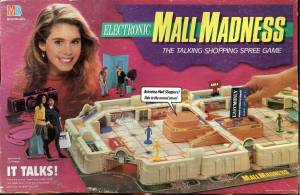
I can only assume that this will lead to a new generation of children developing age-old sneaky monopoly tactics in new and modern ways. Will brothers steal each others identities? Will players have to manage both a monopoly checking and savings account? Will the little debit machine accrue interest on that? Is parking ever really free?
Will strategy become a commodity?

Missed this recent post by the always thought provoking Umair Haque (bubblegeneration.com). He suggests a "law" for the post-network economy is that strategy becomes a commodity:
"Today, the average corporation is packed to the gills with strategists. It's up to it's ears in strategy consultants. The language, vocabulary, and ideas of strategic thinking permeate it.
And that's no surprise - strategy is a very useful way to think about commerce (art, life, etc).
But that also means that everyone and their grandmother knows how to pick profitable markets, segment them, price goods and services, analyze competitors, understand industry economics, etc, etc.
Strategy itself, in a very real sense, is becoming a commodity."
He may have a point. The business world is indeed crawling with strategists. He instead sees creativity as the logical source of value creation:
"I think it is going to have to do with creativity. In a world where strategy is a commodity, creativity becomes the vital factor from which value flows. When everyone can think strategically about everything, the locus of value creation shifts from out-thinking everyone to out-creating them."
Hard to argue with that. However, the proliferation of "strategists" does mask a fact most of us have observed first hand. Creating a strategy is easy. Creating a great strategy, not so much. Creating a brilliant strategy that actually moves a business to reevaluate how it does business is even harder. Most of what passes as strategy these days are actually tactics - a suit of clothes worn for a few days and then discarded. I continue to believe that creativity that bubbles up from a brilliant (though not rigid) strategy, itself informed by a powerful insight - will generally beat raw, untethered creativity.
However, whenever I read the most celebrated cases in business books, I have the nagging suspicion that the "strategy" was tacked on after the fact. Hmmmm.
Friday, July 21, 2006
Trend: Mashups: No-Danger-ous

Danger Mouse burst into the public spotlight, marrying Jay-Z to the Beatles in what is known as The Grey Album. (Trivia: His original files for the songs were labeled "The Black-White Album".) Now Sound Advice has done the same with his group Gnarls Barkley (DM and Cee-Lo) and the legendary Notorious B.I.G. - not all from the Ready To Die disc as the image would suggest. It's called gnarls BIGGIE. Enjoy.
Pretty good, though I'd take the Frank Sinatra + the black Frank White (Biggie) mashup over it anyday. (Sorry, you have to
purchase.) Anyway, let's see how the dynamic duo plays it. Apparently mp3's have already been removed from MySpace and the like, so I'd get there fast. You'd think that Danger Mouse would be sensitive to the project, but I highly doubt it. For a guy who wants to be the first real music director.
Shout out to Protein Feed
Thursday, July 20, 2006
Trend: "Don't Panic": The Fear Premium

"Don't Panic", but a heightened state of fear has become the new normal in America...see the signs all around us here, here, here, herre, and here.
But look at the bright side and you'll see that certain stocks and commodities are reliably up during recent hurricanes, tsunamis, earthquakes, wars or any other catastrophe. These stock values are so reliably up that you may invest - even bet odds with your bookie, on an event's effects. Death and destruction in the forecast? Hot tips suggest buying shares on Tropicana, Home Depot, and even Big Oil to reap some profitable returns on human suffering and destruction.
This speculative effect is something that politicians, economists and traders call the "Fear Premium". From what I deduce, Fear Premium is the bonus boost in sales or stock valuations before, during or after a big calamity. If you're a retailer or distributor, you can gauge the additional supplies and rations required to ship to opportunity danger zones, and turn a slow sales season red-hot. If you're Joe E-Trader, you can plot pending war strikes and buy low oil shares early before the fear spikes oil prices and sparks runs at the pump.
The strangest thing about Fear Premium is that news commentators and economists constantly refer to the Fear Premium in news articles and interviews...yet noone ever fully explains Fear Premium. Seemingly, the first rule of Fear Premium is that you just don't talk about Fear Premium.
So, don't talk about Fear Premium, but certainly profit from Fear Premium!
If stock trading is too complicated for you, then keep it old school and put a few lunch bucks down on the latest Hurricane odds betting sites and like Powerball, you just may be a winner!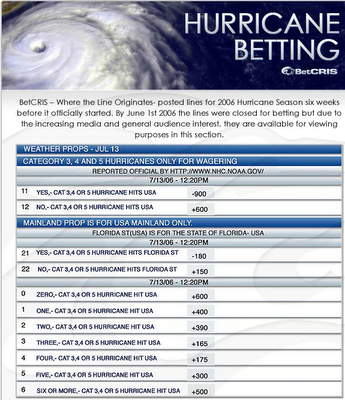
Trend: Bankrupt!: Stop! HammerTime!
 In keeping with the trend of mega-rich stars who can't manage a big buck...
In keeping with the trend of mega-rich stars who can't manage a big buck...
Nashville, TN startup EverGreen Copyright has acquired the music catalog of MC Hammer from the trustee of the rapper's bankruptcy estate for $2.7 million.
Evergreen, which was launched six-months ago by industry veterans Joel A. Katz, David K. Schulhof, and Richard Perna, now controls over 40,000 copyrights.
"We made tremendous progress in only six months," said David K. Schulhof, co-CEO of Evergreen. "The MC Hammer catalog brings some of the best selling and most popular rap songs of all time to Evergreen's catalog."
Songs in MC Hammer's catalog include "Turn This Mutha Out," from the rapper's breakout double platinum release Let's Get It Started, as well as "Too Legit To Quit," "Pray" and one of rap's biggest selling singles, "U Can't Touch This," which helped the rapper's 1990 release Please Hammer Don't Hurt 'Em to sales in excess of 10 million copies.
"We anticipate that many songs in the MC Hammer catalog will emerge as a perfect fit for licensing in movies, television shows, and corporate advertising," Schulhof added.
MC Hammer filed for bankruptcy protection in 1996, with debts in excess of $14 million, despite raking in over $33 million in 1991.
Some of the rapper's assets included a luxurious mansion valued between $12 and $20 million dollars, 17 race cars, a Boeing 727, a Kentucky Derby race horse and a monthly payroll of over $500,000.
via AllHipHop.com
Wednesday, July 19, 2006
Urban Spam: Birth of a movement?

The folks at PSFK have put together a video (see link) decrying the explosion of urban advertising and messaging. They actually go so far as labeling it "urban spam", a catchy and instantly graspable concept. Have PSFK identified a growing movement or are they, themselves trend watchers, attempting to create one?
In many environments, I think some of this stuff actually adds a unique texture, energy and sense of diversity to the urban experience. But clearly, there can be too much of a good thing. Are we there? What is the difference between "urban spam" and adding an unexpected and enjoyable urban moment? (I think I just answered my own question) Can we resist making the urban experience the annoying, cluttered world that is broadcast TV? Past experience would seem to suggest we will #@!$ it up before we learn a thing called "good judgement".
Tuesday, July 18, 2006
Trend: Truth Awareness: Car Dealer Honesty
 I've been brewing a theorem for a minute about a rising tide of raw truth running throughout much of today's merchandising and advertising strategies.
I've been brewing a theorem for a minute about a rising tide of raw truth running throughout much of today's merchandising and advertising strategies.
Within this On-Demand age of increased control and unlimited choice has evolved a new “Truth Aware” consumer, who is endowed with a veritable x-ray vision of previously hidden facts, pricing, production process, program codes, and backstage workings of politics and business. This growing sophistication is downright forcing brands and politicians into a strategic corner to just give up the truth in the sell.
One great example of this growing Truth Awareness is via AdPulp, who points to a Florida car dealer's blog.
The President of Earl Stewart Toyota goes AWOL from his dealer fraternity and exposes the truth about car buying on his blog,Earl Stewart On Cars
Featuring raw truth topics like "What to do if you are Treated Badly by a Car Dealer", "Always Get an “Out the Door” Price", "The Right Used Car is a Better Buy than a New Car", or "Bait and Switch Advertising - Read the Fine Print", he gives open advice to car buyers and owners on how to deal with dealers, service people, and the typical pitfalls to avoid.
Here's a sample:
The “Big Sale Event”. If you look in today’s newspaper, you will find that most car dealers in your area are having a sale of some kind. It may be because of a current holiday, “too large an inventory” of cars, to “reduce their taxes”, “the manager is out of town”, or some other nefarious lure. Advertising 101 says that you should give the prospective buyer a “motive to act”. Unfortunately it doesn’t matter whether the motive is real or not. The fact is that most car dealers do not sell their cars for less during “sales events” than they do at any other time. I point this out so that you don’t rush your buying decision. If you don’t buy a car during the tight time constraints of a phony sales event, you can negotiate just as good a price the next day. The exceptions to this are legitimate rebates offered by the manufacturer. These often expire at the end of the month which is one reason why the “last day of the month” really can be the best time to buy a car”.
How refreshing: a dealer communication without hyperbole and slick imagery, but rather, an eye-to-eye truthiness about the car buying process and benefit to you the consumer. Ironically, this simplicity endears the reader to the dealer in a way that decades of "crazy ed" histrionics never could.
Trend: Geo Mapping: Socialight

More user-created Geo Mapping.
Socialight lets you put virtual "sticky" notes called StickyShadows™ anywhere in the real world. Share pictures, notes and more using your cell phone.
Each StickyShadow that you create can be made public or available only to specific people - like your contacts or members of your groups.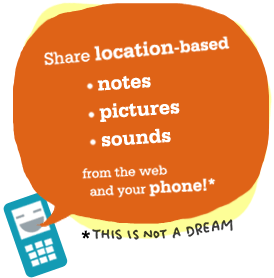
As you travel around the world, you can find StickyShadows that are tied to the places you go. The system can notify you via your mobile phone any time you step on a StickyShadow. As your phone buzzes, it will display the media, along with some information about the person who set it. From there, you can instantly respond, leave your own StickyShadow or just move on.
How's it Used?
•I leave a note for all my friends at the mall to let them know where I'm hanging out. All my friends in the area see it.
•A woman shows all her close friends the tree under which she had her first kiss.
•An entire neighborhood gets together and documents all the unwanted litter they find in an effort to share ownership of a community problem.
•A food-lover uses Socialight to share her thoughts on the amazing vanilla milkshakes at a new shop.
•The neighborhood historian creates her own walking tour for others to follow.
•A group of friends create their own scavenger hunt.
•A tourist takes place-based notes about stores in a shopping district, only for himself, for a time when he returns to the same city.
•A small business places StickyShadows that its customers would be interested in finding.
•A band promotes an upcoming show by leaving a StickyShadow outside the venue.
See a demonstration videohere
Monday, July 17, 2006
Industry: Food Media: EggFusion
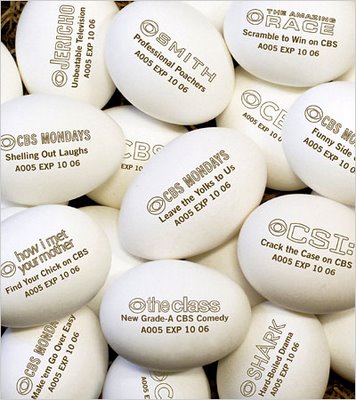
NY Times reports on CBS' fall campaign to brand shows on the surface of 35 million eggs.
Some of their planned slogans: “CSI” (“Crack the Case on CBS”); “The Amazing Race” (“Scramble to Win on CBS”); and “Shark” (“Hard-Boiled Drama.”). Variations on the ad for its Monday night lineup of comedy shows include “Shelling Out Laughs,” “Funny Side Up” and “Leave the Yolks to Us.”
Newspapers, magazines and Web sites are so crowded with ads for entertainment programming that CBS was ready to try something different, said George Schweitzer, president of the CBS marketing group. The best thing about the egg concept was its intrusiveness.
“You can’t avoid it,” he said. He liked the idea so much that he arranged for CBS to be the only advertiser this fall to use the new etching technology. The CBS ads are the first to use imprinting technology developed by a company called EggFusion, based in Deerfield, Ill. Bradley Parker, who founded the company, wanted to reassure shoppers that egg producers were not placing old eggs in new cartons, so he developed a laser-etching technique to put the expiration date directly on an egg during the washing and grading process.
As EggFusion sees it, consumers look at a single egg shell at least a few times: when they open a carton in the store to see if any eggs are cracked, if they transfer them from the carton to the refrigerator, and when they crack them open.
Mr. Parker said the destination of eggs was tracked so precisely that he envisioned being able to offer localized advertising, even aiming at specific ZIP codes, to promote events like local food festivals and concerts. He is setting aside a portion of the ads for charities, too, he said. The imprint is applied in the packaging plant, as the eggs are washed, graded and “candled,” or inspected for flaws, when the eggs are held by calipers and moved along a production line at 225 feet a minute. Right before an egg is packaged, laser light is applied to the shell, giving it the etching. Each imprint takes 34 milliseconds to 73 milliseconds, so the processing of eggs is not appreciably slowed down, Mr. Parker said.
The etching is ultrathin, to a depth of 50 to 90 micrometers, or 5 percent of the shell’s thickness. The imprint cannot be altered without breaking the shell, Mr. Parker said, in contrast to Europe, where ink is used to apply expiration dates on eggs.
Sunday, July 16, 2006
Friday, July 14, 2006
Trend: Bankrupt!: Oprah's Debt Diet

Ok, Murray has convinced me! Or Oprah has convinced me! Whatever, I am convinced!
The answer is Oprah. Oprah can, indeed, save us all.
I know, I was resistant, too. I laughed when Murray responded to my "Trend:Bankrupt!" posts with the recommendation of "Oprah"...like those zeolots on the train who answer every question with "Jesus". But I have caught some late nite episodes of Oprah's 5-Part Debt Diet series and, dammit, I am now trimming out my own needless expenses and saving "as much as $13,000" from unneeded daily purchases like Starbucks and take-outs.
There is something oddly therapeutic about seeing others' debt travails. And others' successes. Something about the can-do-ness of these shows is motivating me to eliminate debt out of my life. How does such a perversely-rich TV star make me feel so comforted about my spending flaws? Oprah seems to actually...know me.
Could Oprah actually convince the whole nation to moderate their spending, too?
For the record I am not turning soft or anything. I am only watching Oprah for the Debt episodes, honest! For work purposes, you know, looking critically at pop culture and stuff. Really!
Thursday, July 13, 2006
Epicurious Etymology

While researching a trend I like to call "Meatrosexuality" (the rise of exotic quality meat connoisseurs), I found out that a few months ago an australian magazine held a competition to come up with a new name for kangaroo meat. The kangaroo meat industry has had success in other countries, but has had trouble convincing native australians that they just were not the cutest-wootest-little-things-in-the-world-yes-they-are!
The winning name, was australus. Which was of course, promptly rejected. I liked jumpmeat and kangarly. ("Whoah! Totally kangarly dude!")
Which leads us to the psychological linguistics of separating meat and animal. First of all, we call it meat instead of flesh. Let's run through some of the english usages: Beef for Cow. Pork for Pig. Veal for Calf. Mutton for Sheep. Venison for Deer. Etymology holds that a long time ago, Anglo-Saxon commoners (who tended the cattle) used the word 'cow', while the aristocratic Anglo-Normans (who did the eating) used the word 'beef.' It's not too far fetched to believe that commoners treating their cows as pets and aristocrats treating their beef as food have a lot to do with modern eating habits.
This leads into how we treat the emotional connection between was is edible, and what is inedible. Rarely (unless we're feeling hilarious) go to a restaurant and order a "Pig Sandwich" or a "Cow Pie." Chick-Fil-A has had a lot of success with being the champions for cows. Now, of course, what animals are getting left out of having special words here? Chickens. And other assorted poultry and fish of course. The closest thing for chickens is Pollo, but eating chickens has become so ingrained into our culture as pure "meat" that calling it a Chicken Sandwich really has no detrimental psychological effects. My guess: Cows/Deer/Pigs share mammalian features that we can see a bit of human in. Birds? Fish? Totally fucked up and alien to us. Let's eat them and farm 'em.
ASIAN NOTE: Just in case you wanted to know, dog meat in Korea is referred to as gaegogi. And the reason why cats aren't eaten more often is just that they don't have enough meat on them except for the thighs which make delicious meatballs.
Fashion: Targèt Couture

Target recently licensed its logo and name to a consulting firm, Brand Central LLC, for use in a new line of high-end clothing called Targèt Couture (pronounced "Tar-zhay"). The line of products, which range from $140 pair of jeans to an $870 Swarovski Crystal clutch purse to $3,185 gold diamond necklace, can be found at the trendy L.A. boutique, Intuition. 
www.shopintuition.com
As a Midwesterner who's frequented Target since the late 70s/early 80s and takes credit for inventing the name Targèt, I find this new line to be rather silly. But hey, even the celebrity snobs need their dose of Target. I am sure most of them wouldn't be caught dead buying a $25 pair of Mossimo jeans.
In all sincerity, I give props to Target. They are probably the only discount store brand that could pull this off. Seriously, could you imagine this on the ass of your jeans? 
Me neither.
Industry: Gods of Advertising
 Bow your heads, ad mortals, and see/hear the words of the Gods of Advertising.
Bow your heads, ad mortals, and see/hear the words of the Gods of Advertising.
These rare video interviews with Keith Reinhard, David Ogilvy, George Gallup, George Lois, William Marsteller, William Bernbach, Leo Burnett, Lester Wunderman, Tom Messner are certainly worth a minute of your time...and a moment of silence.
It's good to put a human essence back into the mythic initials behind today's biggest ad agencies.
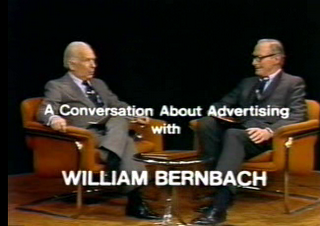
Wednesday, July 12, 2006
Hope for the rest of us

It turns out that there are (at least) two types of genius. The prodigy model we're all accustomed to, people who do brilliant work early but don't ever hit the highs later in their careers; and those who develop their genius more slowly and often make breakthroughs quite late in life.
This recent Wired article written by a member of the latter is a good read. It warns that we might be too quick to write people off if they don't deliver early in life - it feels there's a really interesting strategy in that insight.
Trend: "The Unbanked": Payday Lending
 Between increases in living costs and slowing in real wage hikes lurks predatory (and profitable) lending networks.
Between increases in living costs and slowing in real wage hikes lurks predatory (and profitable) lending networks.
A payday loan is borrowed against a borrower’s future paycheck with fees averaging 390% APR or more (compare to average 18% credit card cash advance).
During the past decade payday lending has exploded, generating about $40 billion a year in loans and $6 billion in finance charges while catering to those who live paycheck-to-paycheck or have been shut out of mainstream financial institutions. 
Fueled by banking deregulation, increases in bad/impaired credit, rises in personal debt, and surges in immigrant populations, as many as 14 million of the 105 million U.S. households use payday lenders annually.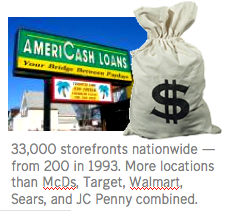
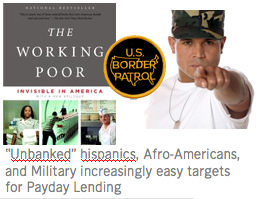

Listen to an NPR interview with Howard Kargermore, author of "Shortchanged: Life and Debt in the Fringe Economy" here
Tuesday, July 11, 2006
Postmodern Post-disaster Vernacular
 "The professional challenge, whether one is an architect in the rural American South or elsewhere in the world, is how to avoid being so stunned by the power of modern technology and economic affluence that one does not lose sight of the fact that people and place matter..." Samuel Mockbee
"The professional challenge, whether one is an architect in the rural American South or elsewhere in the world, is how to avoid being so stunned by the power of modern technology and economic affluence that one does not lose sight of the fact that people and place matter..." Samuel Mockbee
Last week, the Louisiana Recovery Authority released online in PDF format the Architectural Pattern Book that outlines the reconstruction of the areas devastated by last year's hurricanes. It will be given away for free at hardware stores throughout the area, and serves as a toolkit during this critical period of Louisiana architects and urban planners attempting to recover the essence of a community lost. The other option in the extreme, is a high art postmodern catastrophe. The question however, is how far should we imitate classic and traditional elements like we're building a gigantic museum? Was New Orleans ever meant to be clean?
My family got its start there about 25 years ago. To me, New Orleans will always be the smell. It's this near-rancid mixture of the Mississippi, the broken flood and sewer system, and sometimes, urine. But it is what it is. It was always a city marked by extreme yet eccentric poverty. People ask, "Why would anybody live there?" Well, you don't really have a choice, and the carefree attitude towards a badly drawn lot in life made impending disaster a part of the culture.
Last year I was sitting in an Alabama oyster bar with my old roommate whose east New Orleans apartment was underwater. We knew that the smell, and the New Orleans we knew, was washed away like a bad song. Contractors were buying up land for cheap. The only people left were the rich folks on dry land. Gentrification was on its way.
A toast was made. "Here's to Disney New Orleans."
props to Veritas et Venustas
Trend: Bankrupt!: Retiring In The Red
 Many Americans are now arriving at retirement age with an average of $60,000 in savings including their IRAs and their 401ks. That is not nearly enough to pay for a retirement that could easily last 20 or 30 years. And the Center for Retirement Research at Boston College finds that 43 percent of workers risk being unable to maintain their standard of living in retirement.
Many Americans are now arriving at retirement age with an average of $60,000 in savings including their IRAs and their 401ks. That is not nearly enough to pay for a retirement that could easily last 20 or 30 years. And the Center for Retirement Research at Boston College finds that 43 percent of workers risk being unable to maintain their standard of living in retirement.
The Employee Benefits Research Institute reports that more than 1/2 of workers age 45-54 have saved less than $50,000 for retirement. A recent Fidelity study found that the average boomer is on track to replace just 60% of his or her current income in retirement, even with help from Social Security and pensions.
According to a 2003 study "Retiring In The Red", conducted by Demos, nearly one-third of senior citizens in the U.S. carry card balances. But within that group, the average debt is $4,041 — an 89% increase over the past decade. (For all age groups, the average increased by 53% over this same time period, according to Demos.) The debt increase is particularly sharp during the first years of retirement, the study found: People aged 65 to 69 saw their credit-card balances grow by 217%, to $5,844, during the decade. And since the data used in the study come directly from consumers, rather than creditors, the real numbers could be much higher.
The rate at which retirees are filing for bankruptcy has more than doubled over the past 10 years. Retirees are now the fastest-growing segment of bankrupted Americans, according to research by the Consumer Bankruptcy Project at Harvard University.
Credit-card debt used to be considered rare among the elderly, many of whom have spent most of their lives not owning a credit card, let alone carrying a balance that's beyond their means. But it is rare no longer. 
"Credit-card debt is becoming common among older Americans in the same way it's common among all other age groups," says Tamara Draut, a director at Demos, a New York-based research and advocacy company, and co-author of "Retiring in the Red" study.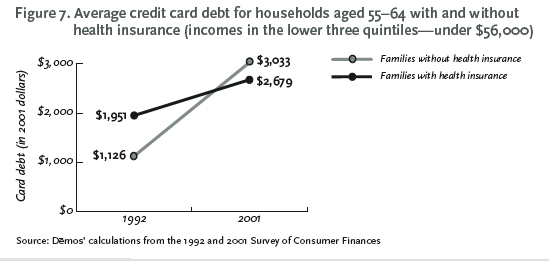
Among seniors (over 65) with incomes under $50,000 (70 percent of seniors), about one in five families with credit card debt is in debt hardship - spending over 40 percent of their income on debt payments, including mortgage debt.
And more are coming. As the transitioners (aged 55-64) are spending 31 percent of its income on debt payments, a 10 percentage point increase over the decade.
What's driving this trend? Longer life expectancies, soaring medical costs, and a bear market that blindsided many seniors. Survival Debt and the American Consumption Ethic have left little to invest for our future retirements. Expect to face more of this as we exit the age of the corporate pension and enter the age of the decline of Social Security assistance, or even inheritances. Of course, there is still the Lotto.
Trend: User-Created: Hip-Hop's "Unwelcome Attention": Bubbly Wars
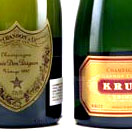
See here, here, and here for the funny saga of the snooty frenchmen who regret hip-hop's endorsement of their pricey grape juice, and Jay-Z's declaration of war on the ingrates.
This week in Cristal Bubbly Wars:
-Beyoncé switched to “lighter” drinks at a recent music awards show, said a spokesman.
-Rihanna said she would toast the success of her new song "SOS", a remake of British duo Soft Cell’s Tainted Love, which is high in the American pop charts, “with something not Cristal”.
-Lil Kim has joined the anti-Cristal movement. Last year, when she was facing jail on perjury charges, she toasted her farewell in Cristal. Upon her release last week she stocked her July 4 party with Krug.
Take dat, Frenchies!
And, still not knowing when to keep a loud mouth shut, Louis Roederer Cristal has issued another dumb statement saying Jay-Z’s accusations of racism were “unjust”, but adding that it had been “a little bit dismayed at seeing our wine being sprayed around in celebration rather than being sipped”, a comment on a common scene in rap videos which may have compounded the original sense of injury.
Why won't this dude just please stay quiet? Is there no P/R fireman over there? Sheesh.
I do admit, though, there is indeed a pathetic irony in hip-hop's enthusiasm to give a united voice to the silly issue of champagne branding over so many other pressing issues where these artists could have massive impact. But maybe this could spark a hip-hop movement to espouse eating more of our veggies or retirement saving and investing money! Youth education? Driving an economically-sensible auto? Carpooling? No? Eh.
Woodsy Wisdom & Brawny Academy Webisode 3

Along with this weeks new episode following the Brawny husbands-in-training comes some Woodsy Wisdom from the man himself. The Brawny Man.
http://www.brawnyacademy.com/woodsywisdom.html?wisdom=2
The woodsy wsidom covers many of the key areas the Brawny Man is trying to encourage his charges in:
- Just Listening
- Wooing
- Staying Positive
- Hygeine
- Home Protection
But of course, through all of that, the most important one of all:
- Staying Manly.
Enjoy!















